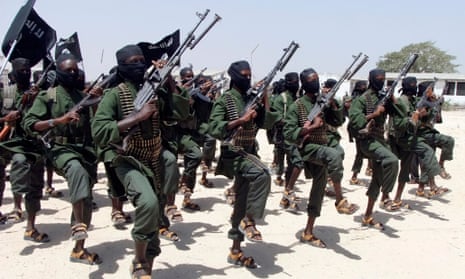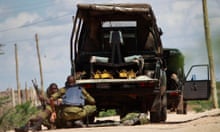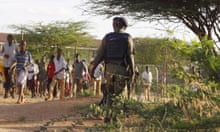The dawn raid on students in Garissa – estimated to be al-Shabaab’s 17th attack in Kenya in three years – came with a harrowing echo of what caught the world’s attention at the Westgate shopping mall. The militants claimed to have taken Christians hostage while sparing Muslims.
In the 2013 atrocity in Nairobi, al-Shabaab gunmen asked captives to recite verses of the Qur’an or name relatives of the prophet Muhammad. Those who answered wrong were shot dead. A Jewish man reportedly saved himself by writing Qur’anic scripture on his hand to memorise.
The cold-blooded tactic may be traceable to al-Shabaab’s struggle to establish itself and gain membership of the al-Qaida network. The group, whose name means “the youth” in Arabic, emerged as the radical youth wing of Somalia’s now-defunct Union of Islamic Courts in 2006. It advocates the Saudi-inspired Wahhabi version of Islam, while most Somalis are Sufis. It imposed a strict version of sharia laws in areas under its control, including stoning to death women accused of adultery and amputating the hands of thieves.
Al-Shabaab began courting Osama bin Laden in 2009 with recordings such as At Your Service Osama, according to an Associated Press report based on documents retrieved from northern Mali and Bin Laden’s safe house in Pakistan. Bin Laden rebuffed al-Shabaab, urging it in 2010 to review its operations “in order to minimise the toll to Muslims”.
His death, however, paved the way for al-Shabaab to gain admission to al-Qaida in February 2012. The Somali president, Hassan Sheikh Mohamud, told the Guardian a year later: “Experts are sent by al-Qaida to train and arm and give all the new techniques of al-Qaida to al-Shabaab. Al-Shabaab is an affiliate, an extended hand of al-Qaida, there’s no doubt, there’s a lot of proofs of that.”

Al-Shabaab is believed to have between 7,000 and 9,000 fighters, including a significant contingent from abroad, although its propaganda has recently been struggling to compete with that of Isis and Nigeria’s Boko Haram. From 10 March 2012, it had carried out an estimated 16 attacks in predominantly Christian Kenya, killing at least 317 people prior to Thursday, according to a count by the Mail & Guardian Africa website. Police statistics put the death toll at 312. Al-Shabaab claims it is acting in retaliation for the presence of Kenyan troops on Somali soil.
Last June in the coastal town of Mpeketoni, attackers reportedly went door to door, demanding to know if the men inside were Somali-speaking Muslims. Those who were not were killed – at least 48 in total. In November, a bus was held up outside the town of Mandera and again passengers were separated according to religion, with 28 non-Muslims murdered. Ten days later 36 quarry workers were also massacred in the area, the majority of whom were non-Muslim.
In response to the unfolding hostage drama in Garissa on Thursday, the political activist Boniface Mwangi tweeted: “Lets respond with love not hate. Al-Shabab is trying to use religion to divide Kenyans.”
The policy of targeting Christians remains sporadic and inconsistent, possibly reflecting factionalism and lack of unity. Some attacks have been carried out indiscriminately, with grenades thrown into bars and bus stations. Muslims were among at least 67 people killed and 175 injured at Westgate.
Al-Shabaab has also continued to kill Muslims with impunity in Somalia itself, despite losing significant territory there. Last week it claimed responsibility for a deadly attack on a Mogadishu hotel in which at least 24 people, including six militants, were killed. The siege lasted more than 12 hours as Somalia’s security forces tried to dislodge gunmen who had taken control of parts of the Maka-al-Mukarramah hotel.
The attack on Garissa also raises questions about the quality of Kenya’s state security apparatus, its long-term military commitment to Somalia and whether the government might use such attacks as a pretext for a crackdown that raises fears about threats to civil liberties. A series of foreign travel warnings have crippled the economically vital tourism industry. Just hours before the latest attack began, the country’s president, Uhuru Kenyatta, said Kenya was “safe as any country in the world”.
Communities in Garissa, where illiteracy, poverty and joblessness are rife, have long felt marginalised and neglected by the government in faraway Nairobi. Mwangi said: “A young man in Garissa of Somali origin is seen as a terrorist suspect. That’s where the problem lies.”
Peter Aling’o, a senior researcher at the Institute of Security Studies in Kenya, said: “The government needs to be treating this as a growing problem from within. What is driving Kenyan youth into joining al-Shabaab? What are the political issues, what are the economic issues? We need a national dialogue to give Kenyan youth a sense of belonging and self-worth.”





